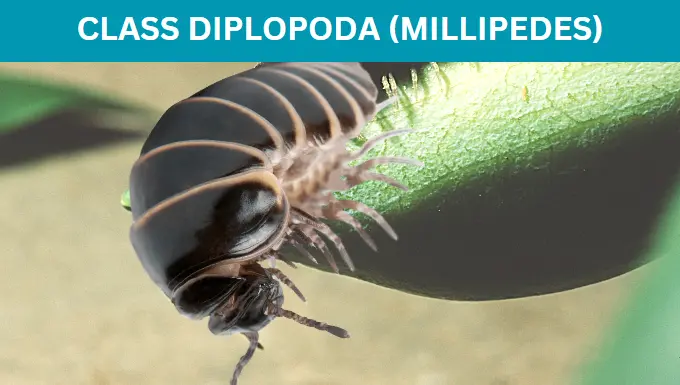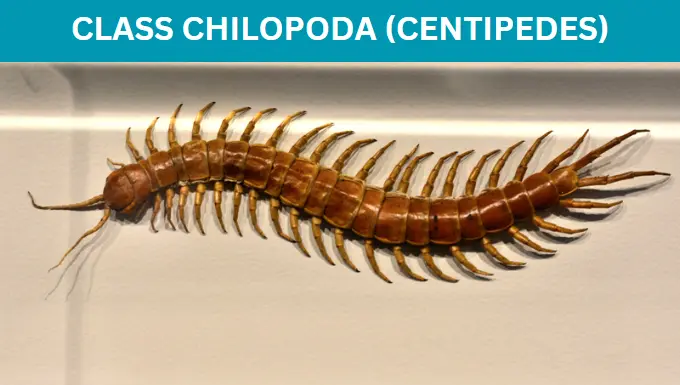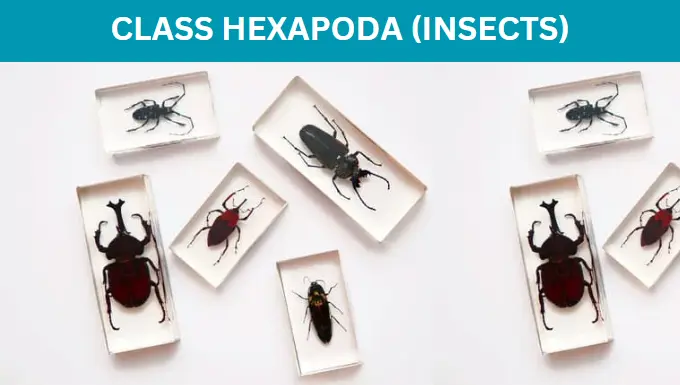Subphylum Uniramia Classification is a taxonomic classification system that groups arthropods with uniramous appendages, such as insects, centipedes, and millipedes.
Arthropods represent a diverse group of animals characterized by their joint exoskeleton, metamerism, and tagmatization. This article will discuss the various classes of subphylum Uniramia and its characteristics.
- Subphylum Uniramia Classification
- A) Subclass Apterygota
- B) Subclass Pterygota
- Superorder Endopterygota
- FAQs
- What is the Subphylum Uniramia classification?
- What are the characteristics of the arthropods in Subphylum Uniramia?
- What is the difference between centipedes and millipedes in Subphylum Uniramia?
- What are some common examples of insects in Subphylum Uniramia?
- How is Subphylum Uniramia related to other arthropod classifications?
- Read Also:
Subphylum Uniramia Classification
The subphylum Uniramia (uni – one, ramus – branch, i.e., single-branches) is one of the four subphyla of arthropods and is defined by having all appendages uniramous, a head with one pair of antennae and one pair of mandibles, and a segmented body.
Within the Subphylum Uniramia, there are several classes, each with unique characteristics and adaptations that have allowed them to inhabit different environments successfully.
Class Diplopoda (Millipedes)
Millipedes belong to the class Diplopoda, characterized by having two pairs of legs per apparent segment and a round cross-section body. Millipedes have a hard exoskeleton and are known for their ability to coil into a ball to protect themselves from predators.
Millipedes are herbivores and play an essential role in the ecosystem by decomposing plant material. (7500 species)

Class Chilopoda (centipedes)
Centipedes have elongated arthropods with one pair of legs per segment, characterized by their poison claws. Centipedes are predators, and they use their evil claws to subdue prey. Some larger species of centipedes can inflict painful bites on humans, although these are rarely dangerous. (2500 species)

Class Pauropoda :
Pauropods are small, soft-bodied animals typically less than 2 mm long. They have 11 segments and nine pairs of legs and live in leaf mold. (380 species)
Class Symphyla :
Symphylans are small, centipede-like arthropods typically between 2 and 10mm long. They have long antennae and 10 to 12 pairs of legs. They live in soil and leaf mold and feed on small soil-dwelling invertebrates. (120 species)
Class Hexapoda (insects):
Insects are the planet’s most diverse group of animals, with more than a million described species. They are characterized by their three pairs of legs, two pairs of wings, and a body with distinct head, thorax, and abdomen regions.
Insects have mandibulate mouthparts, which allow them to feed on a wide variety of food sources. Within Hexapoda, there are two subclasses: Apterygota and Pterygota. (one million species)

A) Subclass Apterygota
Apterygota is wingless insects characterized by pregenital abdominal appendages, ametabolous metamorphosis, and indirect sperm transfer. There are four orders within Apterygota:
Order Collembola
Collembola, or springtails, are tiny insects that inhabit soil and leaf litter. They have antennae with four to six segments and six-segmented abdomens with a springing appendage on the fourth segment.
Order Protura
Proturans are minute insects with cone-shaped heads. They lack antennae, compound eyes, and ocelli and have abdominal appendages on the first three segments. Proturans live in soil and leaf litter.
Order Diplura
Diplurans have many-segmented antennae and lack compound eyes and ocelli. They have multisegmented cerci or forceps-like structures and live in soil and leaf litter.
Order Thysanura
They have a tapering abdomen, flattened body, scales on the body, and terminal cerci. They have long antennae and are commonly known as silverfish.
B) Subclass Pterygota
Subclass Pterygota includes insects that evolved from winged ancestors and have no pregenital appendages, resulting in direct sperm transfer. The superorder Exopterygota is one group of insects in this subclass, and it includes the following orders:

- Order Ephemeroptera: These insects have an elongated abdomen with two or three tail filaments, two pairs of membranous wings with many veins, triangular forewings, and bristle-like antennae. They are known as mayflies.
- Order Odonata: Members of this order have elongated, membranous wings with net-like venation, a long and slender abdomen, and compound eyes that occupy most of the head. Dragonflies and damselflies are included in this order.
- Order Phasmida: These insects have an elongated, stick-like body with reduced or absent wings. Some tropical forms are flattened and leaf-like. Walking sticks and leaf insects are examples of this order.
- Order Orthoptera: This includes insects with long, narrow, and leathery bodies, broad and membranous hind wings, and chewing mouthparts. Grasshoppers, crickets, and katydids are examples.
- Order Mantodea: Members of this order have long prothorax and long prothoracic legs armed with strong pincers for grasping prey and are predators. Mantids are included in this order.
- Order Blattaria: These insects have an oval and flattened body, with the head concealed from above by a shield-like extension or the prothorax. Cockroaches are included in this order.
- Order Isoptera: Termites belong to this order. Workers are white and wingless, while reproductives’ front and hind wings are equal. Reproductives and some soldiers are sclerotized, and the abdomen broadly joins the thorax. They are social insects.
- Order Dermaptera: These insects have chewing mouthparts, thread-like antennae, and an abdomen with unsegmented forceps-like cerci. They are known as earwigs.
- Order Phthiraptera: Small, wingless ectoparasites of birds and mammals are included in this order. Their bodies are dorsoventrally flattened and white. They are known for sucking and chewing lice.
- Order Hemiptera: Insects in this order have a proximal portion of the forewing sclerotized and the distal portion membranous. Sucking mouthparts arise ventrally on the anterior margin of the head. They are known as true bugs.
- Order Homoptera: Members of this order have entirely membranous wings, and their mouthparts arise ventrally on the posterior margin of the head (hypognathous). Cicadas, leafhoppers, aphids, whiteflies, and scale insects are included in this order.
- Order Thysanoptera: These small-bodied insects have sucking mouthparts. Their wings are narrow and fringed with long setae, and they are plant pests. Thrips are examples of this order.
Superorder Endopterygota
These insects undergo holometabolous metamorphosis, meaning their wings develop internally during the pupal stage. They have four distinct stages: egg, larva, pupa, and adult.
- Order Neuroptera: These insects have membranous wings, and their hindwings are roof-like over the body at rest. Examples of insects in this order are lacewings, snakeflies, antlions, and dobsonflies.
- Order Coleoptera: Beetles are the largest insect order and have sclerotized forewings that form covers (elytra) over the abdomen. Their hindwings are membranous, and they have chewing mouthparts.
- Order Trichoptera: These insects are moth-like with setae-covered antennae and chewing mouthparts. Their wings are covered with setae and are held roof-like over the abdomen at rest. Their larvae are aquatic and often dwell in cases that they construct. Examples of insects in this order are caddisflies.
- Order Lepidoptera: These insects have broad wings covered with scales, and their mouthparts are formed into a sucking tube. Moths and butterflies belong to this order.
- Order Diptera: These insects have well-developed mesothoracic wings, while their metathoracic wings are reduced to knob-like halteres. They have variously modified mouthparts but never have chewing mouthparts. Examples of insects in this order are flies.
- Order Siphonaptera: These insects are laterally flattened with sucking mouthparts and jumping legs. They are parasites of birds and mammals; examples of insects in this order are fleas.
- Order Hymenoptera: These insects have membranous wings with few veins and a well-developed ovipositor, sometimes modified into a sting. Their mouthparts are modified into a sting and lapping. Some species are social, while others are solitary. Examples of insects in this order are ants.
FAQs
What is the Subphylum Uniramia classification?
Subphylum Uniramia is a taxonomic classification that refers to a group of arthropods with unbranched appendages, including insects, centipedes, and millipedes.
What are the characteristics of the arthropods in Subphylum Uniramia?
The arthropods in Subphylum Uniramia have several common characteristics, including unbranched appendages, a single pair of antennae, a ventral nerve cord, and an exoskeleton made of chitin.
What is the difference between centipedes and millipedes in Subphylum Uniramia?
Centipedes and millipedes are arthropods in Subphylum Uniramia but have distinct differences. Centipedes have one pair of legs per body segment and are carnivorous, while millipedes have two pairs per body segment and are herbivorous.
What are some common examples of insects in Subphylum Uniramia?
Insects are the largest arthropods in Subphylum Uniramia and include familiar organisms like ants, bees, beetles, butterflies, and moths.
How is Subphylum Uniramia related to other arthropod classifications?
Subphylum Uniramia is a subphylum within Arthropoda, including subphyla Chelicerata and Crustacea. Chelicerata includes spiders, scorpions, and horseshoe crabs, while Crustacea includes crabs, lobsters, and shrimp.
